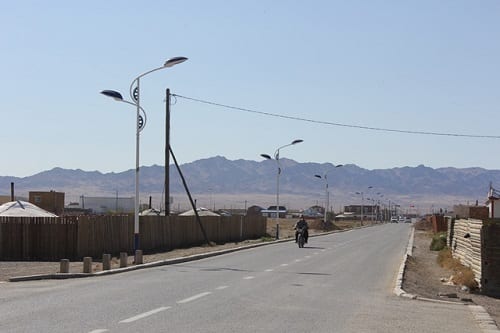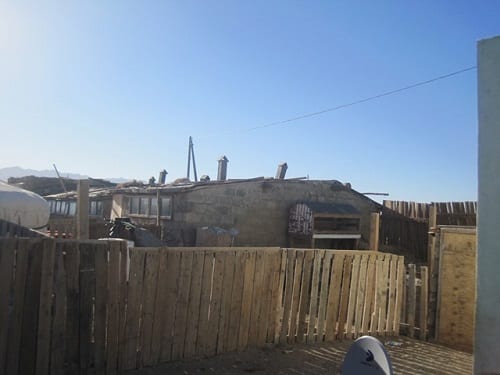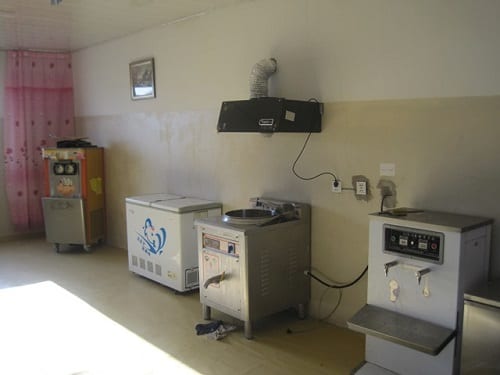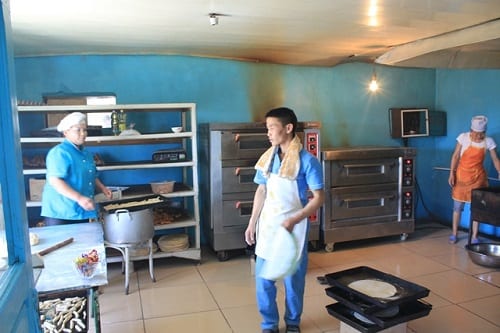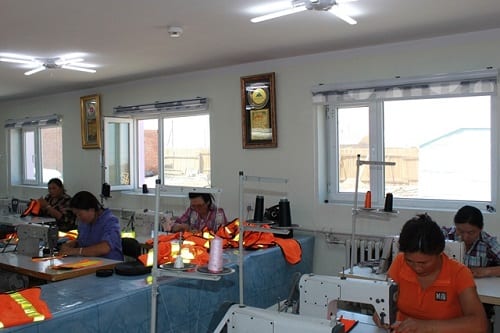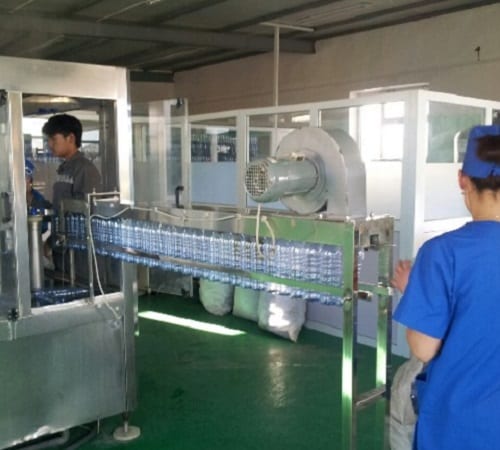Doing Business in the New Economy: Stories of ‘Wealth Creators’ in Dalanzadgad
By uczipm0, on 8 April 2015
By Byambajav Dalaibuyan
Dr. Byambajav Dalaibuyan is an Affiliated Member of our project, currently based at the Centre for Social Responsibility in Mining (CSRM) at the University of Queensland, Australia.
Two years ago, when the Mongolian economy was experiencing double-digit growth, I conducted a scoping study on small business developments in Dalanzadgad, Umnugovi, jointly with business development specialists. We had two days. The first day involved meetings and a public talk by our international guest. The second day, we managed to visit three local businesses: a dairy farm, a bakery and a work clothing manufacturer. All had received training for business development. Surprisingly, all were run by women. They showed us their workplaces and told about how they had started and run their businesses.
Dalanzadgad
Dalanzadgad (soum) is the capital city of Umnugovi province and is ‘host’ to many mining projects, including the giant Oyu Tolgoi and Tavan Tolgoi mines. The centralised governance system does not allow the local government to gain any more benefits than others, so the growth of revenue from mining will not necessarily make this place any wealthier. However, there have been indirect and multiplier effects of mining on the local economy and wealth distribution.
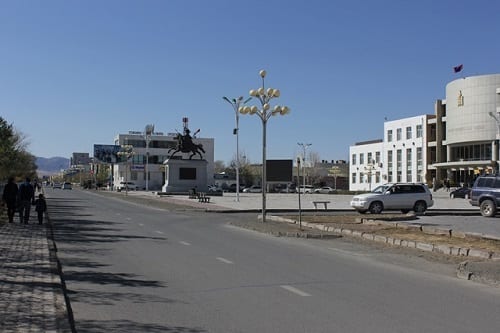
Center of Dalanzadgad, with government building on the right (Photo by Byambajav Dalaibuyan, 2013)
Unlike other aimags, Umnugovi owns 51% of the ‘small’ Tavan Tolgoi mine. The government dividends allowed the aimag government to distribute on-off cash handouts worth 500,000 tugriks to every Umnugovi citizens during the boom period. The mine is still the biggest contributor to the aimag budget.
Dalanzadgad is the most populous soum in Umnugovi. It has approximately 20 thousand residents (while other soums have on average 3500-5000 people). For many it is difficult to sustain a business only relying on local demand. Relatively bigger soums like Gurvantes, Tsogtsetsii and Khanbogd have the same problem, but they have the big mines nearby which could become potential markets for their businesses. Prices are a bit high in Umnugovi, partly because it is remote and an average income level is above average. The landscape of the town has been changing quite rapidly in the past few years. There are new shopping centres, apartment buildings, and hotels. The asphalt road connecting the main districts of the town have recently been constructed.
‘Businesses have been affected most’, said a local businessman about the impacts of the current fiscal crisis. ‘We, ordinary people living by our salaries don’t feel the pressure’, he continued. ‘Instead’, he said, ‘it is people at the top and bottom of the society, which means big businesses and the poor, who have suffered most from the fiscal crisis’.
This year (i.e. 2015), luckily, I had a chance to visit the three businesses again. I wanted to see how they had changed since 2013. The high expectation that mining would boom continuously has not been met. I was curious about how these businesses had adapted to this change. I was not able to meet one of the three businesses, but in addition I was able to meet the owner of a new pure water plant business. This added insights on how the economy is being experienced on the ground by local small businesses.
‘Wealth creators’
The term ‘wealth creator’ (Баялаг бүтээгчид) is becoming a buzzword in Mongolia. It seems to denote those people who create economic value but it is also used with different meanings. Some people refer to people who manufacture goods locally as ‘wealth creators’, while people who produce goods for export and replacing foreign imports are particularly praised as ‘wealth creators’. The term was used widely by the Government of Prime Minister Altankhuyag. For example, it convened the ‘Wealth creator-young herders’ forum’ in 2014. In many ways the term is a branding initiative aimed to promote the private sector.
Whatever the usage is and beyond its political overtones (and unlike the term ‘Supporting National Manufacturers’ (Үндэсний үйлдвэрлэлээ дэмжье), the new term does have some moral connotations. Doing business is considered engaging in the social good. An important agenda behind promoting ‘wealth creators’ may be concern that the public needs to understand that the backbone of the ‘market society’ is the people who create economic values through their own creativity and hard work and they need to be respected and supported. Perhaps for some people it may be an attempt to differentiate between private wealth accumulated by unknown sources such as ‘billionaires born from the state’ or political riches from that of new value creators by showcasing the latter.
Is mining a ‘wealth creator’? Many people, including those in the extractive industry, think it is. The Ministry of Mining has sometimes used the term referring to miners and mining companies. But that is not shared by some people, including MP G.Uyanga who has recently spoken during a parliament session that local manufacturers such as felt slippers makers are ‘wealth creators’ rather than exploration and mining companies who only dig or extract wealth.
Four stories
I begin with a brighter story.
Dairy farm
When we came to the dairy farm a woman greeted us and invited us to her ger. We wondered where her husband was. She replied that he was working outside in the farm. She was representing her household. It was obvious that our foreign colleagues did not expect this gender difference. When we walked out to look around the farm the husband was feeding their cows and doing other stuff. He did not join our conversation.
It was a small dairy farm located in the outskirt of Dalanzadgad. It was apparent from their properties that the family was not wealthy.
‘I herded a small number of animals for 10 years and then the dzud happened’, she said. Her family lost many animals during the 2009-2010 dzud. Left with a few goats and sheep (100-150), they decided to move to Dalanzadgad. Their hope to find a job was not fulfilled. She spent a year in Selenge aimag with her relatives. Selenge, located in the north, is one of the main agricultural regions of Mongolia and herders often sell milk to customers in nearby settlements and towns. When she returned home she wanted to start a dairy farm.
With low interest loans from the Soum Development Fund and Oyu Tolgoi’s business development project she was able to purchase four cows and other resources. She travelled to Selenge to buy good dairy cows. Her husband built a barn and shelter. They built a house for processing milk at that time and they were selling their milk to local dairy plants and individual customers. She had received business training funded by Oyu Tolgoi LLC and joined a study tour to dairy farms in other regions.
The farm is much bigger now. The barn was renovated to accommodate 20 cows. They commenced a milk plant. They now have contracts with local schools and nurseries to supply their packed milk and yogurt. Some of their products are sold at the local market as well. ‘There were only two dairy plants in Dalanzadgad before we started ours’, she said.
She now wants to have secure pasture and sources of fodder for their cows. She has been to Inner Mongolia with other local businesses to learn about their dairy farms and technologies. ‘Low interest and long-term loans are crucial for business’, she said. She has established a cooperative together with her family and relatives. The cooperative includes the dairy farm and a bakery. Her younger brothers also run a small jewelry shop.
Bakery
A local couple with two young kids invested their money in a bakery. They built a house and a brick furnace themselves. The husband was away when we visited them. He worked for a mining company operating in Gurvantes soum, approximately 300km west from Dalanzadgad. Initially, the husband managed the bakery but it was passed to his wife because of his mining job. The bakery was quite well equipped and it employed three local people.
However, she mentioned that it was struggling to compete with a new bakery that had recently opened in town. The new bakery was run by people who had migrated from the Eastern region of Mongolia and their bread was far better than the local one. The local bakery started to quickly lose their market share. A year ago the bakery supplied approximately 80% of bread in the town but now it dropped to 20%. They did not just sit and lose their market share. They invited a professional from Ulaanbaatar to teach making good quality bread and other products. That did not result in a significant change. They even tried to steal the bread recipe from their competitor by sending their people to be employed by them. The competitor was well aware of that threat and protected its ‘secret’ recipe. Desperate to retain her business, she was starting to make other products, such as noodles and pastries. Unfortunately, I could not contact her and visit the bakery this year. I was told that it was not operating well.
Work clothing maker
The owner and manager was a local woman in her fifties. She was truly a success story. In the workshop nearly 15 local women, some of whom were disabled, worked under her management. She had contracts with some big mining companies to supply work clothing. Oyu Tolgoi was the major buyer. With ‘Made in Dalanzadgad’ labels, their clothes were fashionable and our colleagues praised the quality. We were told that there was an order from Canada to buy their clothes but the distance and pertaining expenses did not allow for it. ‘I am not an educated person, and I do not have the skills to promote our business unless someone helps me,’ she said.
She was unhappy about her business when I met her this year. The previous demand from the main buyer had decreased and the orders from other mining companies are not sufficient to keep her workers paid. She now has fewer workers and employs them an on-demand basis. She was proud that mining companies were aware of the quality of her products. ‘We now have half of the staff we had last year’, she said. ‘The company supplied clothes worth 500 million tugriks in 2013, but it dropped to 140 million tugriks in 2015. Oyu Tolgoi has helped us nurture this company but the local government now needs to help us to promote our business and connect with costumers’, she said. ‘They only contact us for statistical data collection’, she lamented. She had paid for an advertisement of her products on local TV and hoped to attract new clients through their new website.
Water plant
It was a new, two-storey, building. The owner was a man in his mid-30s. He managed it with the help of his wife. It appeared that the plant was very well-equipped and managed. The owner explained to us the processes of producing bottled water, walking with us from one end of the linked machinery to the other. He showed us facilities for the workers such as the dressing room, a shower, and a training room. Many posters about occupational health and safety were displayed.
His bother used to study in Japan. With his help, he arrived in Japan in 2007. He spent about three years in Japan doing a range of casual work. He said that he had learned a lot from Japanese collective work culture, safety rules, and punctuality.
Because I lived in Japan for several years we discussed much about differences between the two cultures. He told me about his first encounter with his employer in Japan. When he arrived in Japan he wore suites and a tie. The employer was looking for a foreign worker but did not expect a man in nice suits. After calling his brother, the employer finally found him. He said that he works with his workers together in the plant and does not put himself in a position of darga. He values stability in the workplace and tries to create a favorable work environment. ‘Safety and hygiene are important. We gave people work clothes, but they often forget them at home. Now we have a dressing room and they don’t need to take clothes home’, he said.
He also recognized that low interest start-up loans were crucial for sustaining his business. The market was important as well. Three of the four water plants in Dalanzadgad sell their water to Oyu Tolgoi. 50% of the water of his plant is procured by Oyu Tolgoi. The other mining companies in Umnugovi procure his products as well. He was aware of diversifying his customers so to avoid overreliance on one customer. He was happy about the success of his business. He started this business in the basement of an apartment with four workers. Now he earned a solid market share. He said that the demand for bottled or packed water was increasing in Dalanzadgad because people are concerned about their health. He has 4 trucks which they use to deliver water to their customers.
Observations
Low interest loans are crucial for all businesses and many small local businesses would not have started without such loans. Commercial banks requirements often include high interest fee (15% annually) over a short term (3 years) and they require different kinds of collateral which are very difficult for start-ups and small businesses to meet. The limited amount of loan distributed through Small and Medium Enterprise (SME) Fund in every aimags and soums has 7% annual interest. Oyu Tolgoi and other mining companies have offered a limited number of loans with relatively low interest. For example, in addition to cash loans, Oyu Tolgoi has supplied materials to clothing companies as a loan. ‘The Minister of Labour visited us and promised to help get 200 million tugriks from the SME Fund but I have not heard anything yet,’ said the owner of the water plant. ‘I borrowed 180 million tugriks from a bank to construct this building and its interest fee would be roughly 100 million tugriks in total’ he continued.
Not many businesses have been established and run by groups beyond families and relatives in Mongolia. This is evident from the stories of small businesses presented here. A bigger organization requires more people, commitment, and trust. When we were in Dalanzadgad in 2013 a local couple asked to meet with us to get advice on their business idea. Six families were hoping to establish a cooperative to produce locally grown pickled vegetables. Their main problem was that four of them were passionate about the project, while the other two were not so confident and they were not sure about how to build a good company.
There have been a range of aid and government programs to develop small businesses or create ‘wealth creators’ in different rural areas of Mongolia in the past two decades. Most local economies are homogeneous and remote. Nomadism and socialism did not create local economic diversification. Many policies and aid programs to increase ‘wealth creators’ have often failed to reach their goals. For example, the ‘One village – One product’ policy promoted by Japanese donors did not result in ‘One soum – One product’. Unfortunately, there have never been follow-up studies of these programs that are publicly available. Although everyone in Mongolia seems to want to support ‘wealth creators’ and the Government of Mongolia seems to seek to increase its support, a local and long-term business support mechanism has not been established. Each of the business mentioned had developed their own approaches and technologies to be able to continue, but they were precarious. It is almost clear now that without creating links to sustainable or large enough markets or customers it will be impossible to develop sustainable local businesses in Mongolia.
 Close
Close



